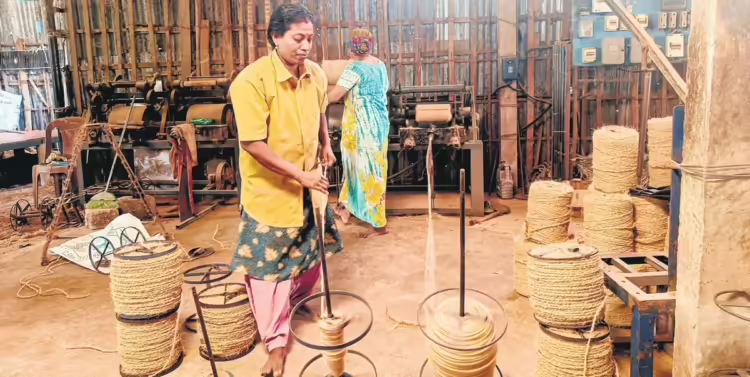In Alappuzha, India, the center of coir manufacturing, laborers look for a rope of hope
The asbestos-roofed Chenganda Coir Vyavasaya Cooperative Society plant, located near Cherthala in Alappuzha, is scorching in the heat. The air is hot and heavy with dust from coconut husks.

About thirty ladies are working hard to make coir, oblivious to the harsh surroundings. similar to robots.
They have ten years of experience working at this facility. They are too attached to their jobs to be dissatisfied with the working circumstances.
What worries them, however, are the problems that beset the industry: low salaries, little government support, a scarcity of raw materials, a decline in the market for coir and value-added goods like mats.
One of the major centers for coir manufacturing in India is Alappuzha. As Congress national general secretary K C Venugopal challenges CPM MP A M Ariff, the incumbent, and NDA member Sobha Surendran, the seat is being monitored.
Workers in this country’s coir industry, however, don’t think the approaching general elections will much improve their lot in life. The general consensus is that politicians have shown little interest in solving problems and never will.
Kavitha, who has worked in this field for more than ten years, said, “Despite raising the issues with MPs, MLAs, and ministers several times, there has not been any effective intervention to resolve the crisis.”
Workers have long demanded raises in pay, but the state administration has shown little interest in complying. For the last eight years, there hasn’t been a pay increase.
Workers at coir factories earn between Rs 300 and Rs 450 a day, from sunrise to sunset. Kavitha, whose mother worked at the same plant, observed, “Many workers now go for MNREGA work as the wages are similar, but the workload is lower.”
In Alappuzha, women make up around 86% of the coir labor force, with 44% of them being in the 50–60 age range.
The majority of employees were hesitant to discuss the surveys and their expectations. They seemed annoyed. Political figures exalt the coir industry throughout their remarks. However, the reality is that none of them have made an effort to comprehend our issue at its core, according to Usha Thangachan, a coir worker of more than 30 years.
Appukuttan Madhavapalli, who has worked in the coir industry for the same number of years, lamented the same thing. “We will most likely be the last generation to work in this sector if the government continues to ignore the coir industry,” he said.
The proprietor of Marottikkal Coir Works, which is close to Arookutty, Babu K, also chastised the government for disregarding the coir sector. He said, “We haven’t received any subsidy for the last five years, despite multiple applications.”
“Reviving the coir sector should be equally the responsibility of the Union and state governments.”
A Marottikkal Coir Works employee named Radhakrishnan suggested that a “commission with extensive industry knowledge investigate the industry’s downfall” be appointed by the government. There are over 700 registered coir units in Kerala, according to the Coir Board of India. Coir items from Alappuzha were in high demand throughout the 1980s and 1990s. Stakeholders claim that as of late, the “focus has shifted to Tamil Nadu.”
“I opened the factory as soon as I graduated. We employed around one hundred people,” he said.
Nevertheless, we were forced to reduce activities when the unit experienced a loss. There are just 20 employees now. A large number of our staff switched to MNREGA job.
Babu emphasized the steps taken by the Tamil Nadu government to support the state’s coir sector. “To recover lost glory, we need similar efforts here as well,” he said.







